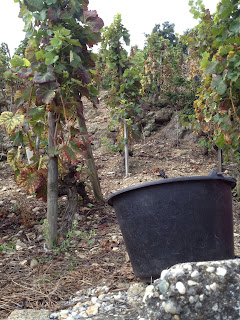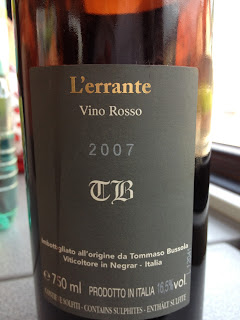A few weeks back we had a tasting of mature amarones from Quintarelli, Dal Forno, Tedeschi, Bertani, Mithas and Accordini - producers which are household names within amarone producers.
While amarones wines can be stored for decades, most of them are drank too young i.e. only a few years after the vintage, not expressing their beauty fully to the taster. However how do they fare up when reaching their maturity? These wines were all excellent apart from one bottle. And acidity was great, offering hedonistic pleasure when combined with dried fruit emerging from the older vintages. One of the better tastings I have encountered in a few years.
The other interesting point was to find out about supremacy within Valpolicella in mature wines - while Quintarelli and Dal Forno are world famous, how do Tedeschi, Mithes and Accordini fare in a same tasting?
I will post up the Valpolicella Tour tasting notes from 2012 to accompany this text later.
Tedeschi's wines were the first flight.
Tedeschi Capitel Monte Olmi Amarone 1974

Vintage 1974 actually carried label "Recioto della Valpolicella Amarone".
A dark garnet color which was surprisingly youngish, with orange on the rim. However the orange rim was quite narrow. Not so surprisingly, notes of raisins and ripe plum on the palate with dark coffee, dark chocolate, black pepper & dark spices. Fruit has nicely dried up here (not entirely!) to give flavours of a christmas cake. Round and broad mouthfeel with minerality and limestone emerging after air time in glass. A beautiful expression of mature amarone, with a medium length in aftertaste (i.e. not short, however not the longest either).
Tannins are still there underneath there while the level of alcohol also warms the mouth. To add to the equation, the level of acidity is really good too. As those are the key components for helping wine to preserve, no wonder it has survived almost four decades.
Drink now. In addition, after getting air for 2.5 hours the wine was going down as notes of used band-aid surfaced. The wine is so mature that it does not need oxygen to open up and it is detrimental to expose it to a too long period of air contact. I would recommend drinking the wine within 1-2 hours after opening.
Tedeschi Capitel Monte Olmi Amarone 1986
The color is still garnet however showing signs of more maturity with more orange in it than in the 1974. The wine was not in perfect shape, the fruit is more in the background and the wine is more greenish, having notes of fresh sprig (or needles) of coniferous tree, mixed with dark chocolate, plum and dark roasted coffee flavors. Acidity is good too. All signs are that this was a nice wine when young however our bottle had not completely survived to this date. Recommendation is to drink Monte Olmi 1986 now and not wait longer.
Tedeschi Capitel Monte Olmi Amarone 1988
A really good wine, especially if you like intensive fruitiness. This is in great balance now. Beautiful garnet color and again a small orange rim, not that different from 1974. Like the older vintage, this one has the raisins however coupled with medicine herbs (the distinctive amarone feeling) and mocha in a full-bodied package. I wrote "really good stuff here" in my notes. Like in 1974, alcohol (15% abv) burns a little straight after opening, however when exposed to air, the wine rounds up. Intensive fruit, almost syrup like, leaving a feeling of a thick layer on the tongue remaining for minute after tasting the wine.
The wine is really well in balance now with good acidity to support it. I had it in a glass for almost 4 hours and the wine was still in good condition, so no need to hurry with it. Drink now or wait for a couple of years, if not a decade. If I would give points to a wine in my blog, which I usually don't do, this would get a 94.
I really like the tannin structure of Tedeschi's young wines produces in the recent years, however the level of acidity in Capitel Monte Olmi amarones was excellent for all three wines.
Corte Sant'Alda Mithas Amarone 1997
Mithas Corte Sant'Alda 1997 was initially slightly reserved and closed. This one needs at least two hours of air in glass and decanting before. Patience really pays off here - if you drink the wine before it has had extensive breathing time, it seems the wine is in a sleeping mode at this point, however waiting to open up in a beautiful state in as the core is beautiful. Herbs, licorice, plums and chocolate are mixed with forest ground, greenish (not in a bad way) notes with hints of cherries, which emerge after being open for 2+ hours. Plenty of fruit in this one, and my overall feeling is that Mithas has produced a quality wine however slightly closed at this point, and it would be interesting to try it again in a few years' time if it is more open as I do not think we saw the vineyard's true potential with this bottle.
Note to myself - try this again.
Stefano Accordini Amarone della Valpolicella Classico Vigneto "Il Fornetto" 2000
Another great expression of amarone, Accordini's Vigneto Il Fornetto 2000 had 12 years of age and the wine has decades ahead for providing hedonistic pleasure to the lucky ones having this one in their cellar.
The wine is in a really good balance. A beautiful, round mouth feel. Dark elements emerge from the glass in an intensive nose of maraschino cherries and plums mixed with dark cherry chocolate and herbs while notes of black tea raise give a dimension not present in the earlier wines in this tasting. Also some mushroom like notes emerge after 2 hours. Cherry liqueur comes in mind since there is a lot of alcohol in this one, however the wine still manages a balance as other components, including acidity, are big too and tannins are nicely integrated. The notes found here give feeling of a multidimensional wine which stands out among amarones. Lots of sediment in the bottle. Still alive after 3 hours in the glass. Drink now or keep in cellar for decades. Should I give points? No, I give a range, which is 94-95.
Quintarelli Amarone della Valpolicella Classico 1998
We tasted Quintarelli's Amarone 1998 alongside Dal Forno's Amarone 1996, and overall feeling is that however big wine the Quintarelli amarone was, it is still somewhat lighter yet in a delicate way than the super-bodied Dal Forno.

A truly outstanding wine. The color is ruby, the wine is still looking quite youngish while having over 14 years of age. Tannins are evident and make the wine last for decades and decades. The fruit is beautiful here - ripe and big, yet delicate. The ripe fruit makes this wine feel more sweet on the palate than what its nose indicates prior to tasting it. Notes of licorice, toffee and milk chocolate as opposing to more dark chocolate in the earlier wines. Oak and smoke. Some lingonberries too, in the feeling of acidity which is great. The greenish notes of herbs often associated with amarone wines are more in form of leafy greenish notes here. Other tasters also commented on burned sugar and balsamico.
Dal Forno Amarone Della Valpolicella 1996
The most full-bodied wine in the tasting, Dal Forno's Amarone 1996 is a dark ruby, meaty, dark, super thick expression of amarone with super ripe fruit, big tannins and a smoky, almost barbecue like, feeling. This is like candy made with mixing tar flavor in it. The mouth feel is unbelievably round even with big tannins and alcohol. Really good balance and acidity here. Plums dominate the big, big extraction of fruit. The other tasters expressed the green feeling in this wine showing in the form of dill.
This wine is sure to please most people, however it also gives a contrast to Quintarelli's delicate 1998 - the question which one is better is like ying and yang balancing - to taste them both at the same time gives you the opportunity to weigh on them and get a more thorough picture of the wines differences. The overall result of the voting in our tasting was Quintarelli's 1998 slightly edging Dal Forno's 1996.
Bertani Amarone 1965
Slightly sweet ripe fruit is still evident in Bertani's 1965 Amarone, i.e. the fruit has not dried up entirely. The wine was really beautiful although showing signs of decline already. Almond, slightly oxidized nose with burned sugar have changed the nose to a liqueur like feeling. Drink it within an hour since it does not last long in the glass. Still it is very interesting and has great acidity.
Bertani is one of the original makers of "dry" amarone, starting in 1950s. It would be great to find these older vintages as this wine gave promise to the quality and longevity of Bertani's wines.
 A nice bottle of Beaujolais makes me smile. There are a lot of wines from the region which are both complex and structured, thus far apart from the Beaujolais Nouveau wine style and very interesting to try. It was a pleasure to open a bottle of Chamonard's Morgon 'Le Clos d Lys' during our six course dinner last Saturday as fellow wine bloggers gathered together for an evening of wines and great food. The evening was arranged in Ceestashop in Helsinki (address Töölöntorinkatu 5).
A nice bottle of Beaujolais makes me smile. There are a lot of wines from the region which are both complex and structured, thus far apart from the Beaujolais Nouveau wine style and very interesting to try. It was a pleasure to open a bottle of Chamonard's Morgon 'Le Clos d Lys' during our six course dinner last Saturday as fellow wine bloggers gathered together for an evening of wines and great food. The evening was arranged in Ceestashop in Helsinki (address Töölöntorinkatu 5).






































